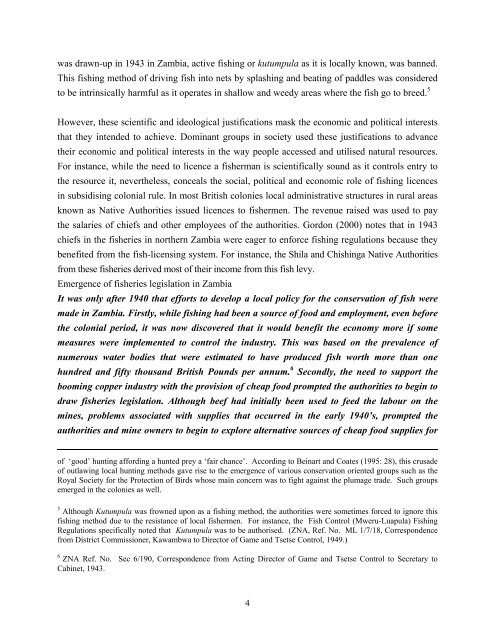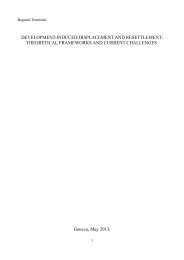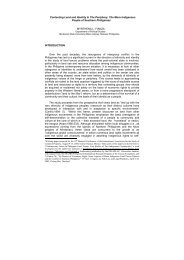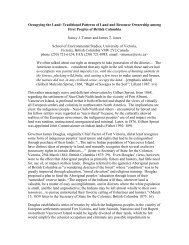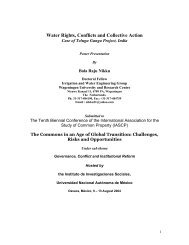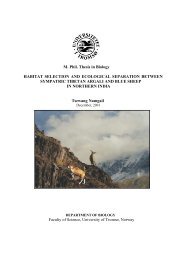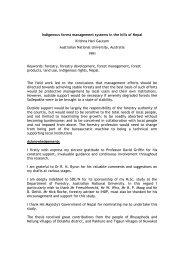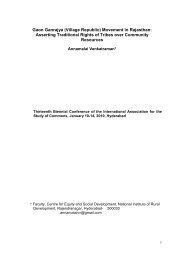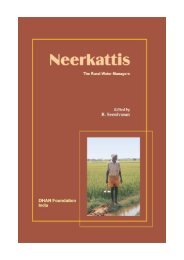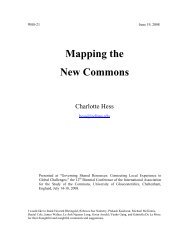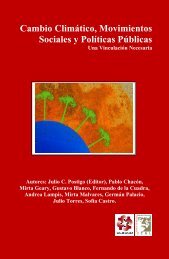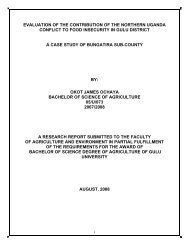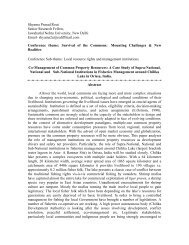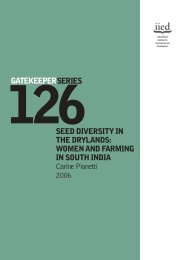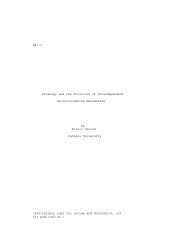The emergence of fisheries legislation and regulations in Zambia ...
The emergence of fisheries legislation and regulations in Zambia ...
The emergence of fisheries legislation and regulations in Zambia ...
You also want an ePaper? Increase the reach of your titles
YUMPU automatically turns print PDFs into web optimized ePapers that Google loves.
was drawn-up <strong>in</strong> 1943 <strong>in</strong> <strong>Zambia</strong>, active fish<strong>in</strong>g or kutumpula as it is locally known, was banned.<br />
This fish<strong>in</strong>g method <strong>of</strong> driv<strong>in</strong>g fish <strong>in</strong>to nets by splash<strong>in</strong>g <strong>and</strong> beat<strong>in</strong>g <strong>of</strong> paddles was considered<br />
to be <strong>in</strong>tr<strong>in</strong>sically harmful as it operates <strong>in</strong> shallow <strong>and</strong> weedy areas where the fish go to breed. 5<br />
However, these scientific <strong>and</strong> ideological justifications mask the economic <strong>and</strong> political <strong>in</strong>terests<br />
that they <strong>in</strong>tended to achieve. Dom<strong>in</strong>ant groups <strong>in</strong> society used these justifications to advance<br />
their economic <strong>and</strong> political <strong>in</strong>terests <strong>in</strong> the way people accessed <strong>and</strong> utilised natural resources.<br />
For <strong>in</strong>stance, while the need to licence a fisherman is scientifically sound as it controls entry to<br />
the resource it, nevertheless, conceals the social, political <strong>and</strong> economic role <strong>of</strong> fish<strong>in</strong>g licences<br />
<strong>in</strong> subsidis<strong>in</strong>g colonial rule. In most British colonies local adm<strong>in</strong>istrative structures <strong>in</strong> rural areas<br />
known as Native Authorities issued licences to fishermen. <strong>The</strong> revenue raised was used to pay<br />
the salaries <strong>of</strong> chiefs <strong>and</strong> other employees <strong>of</strong> the authorities. Gordon (2000) notes that <strong>in</strong> 1943<br />
chiefs <strong>in</strong> the <strong>fisheries</strong> <strong>in</strong> northern <strong>Zambia</strong> were eager to enforce fish<strong>in</strong>g <strong>regulations</strong> because they<br />
benefited from the fish-licens<strong>in</strong>g system. For <strong>in</strong>stance, the Shila <strong>and</strong> Chish<strong>in</strong>ga Native Authorities<br />
from these <strong>fisheries</strong> derived most <strong>of</strong> their <strong>in</strong>come from this fish levy.<br />
Emergence <strong>of</strong> <strong>fisheries</strong> <strong>legislation</strong> <strong>in</strong> <strong>Zambia</strong><br />
It was only after 1940 that efforts to develop a local policy for the conservation <strong>of</strong> fish were<br />
made <strong>in</strong> <strong>Zambia</strong>. Firstly, while fish<strong>in</strong>g had been a source <strong>of</strong> food <strong>and</strong> employment, even before<br />
the colonial period, it was now discovered that it would benefit the economy more if some<br />
measures were implemented to control the <strong>in</strong>dustry. This was based on the prevalence <strong>of</strong><br />
numerous water bodies that were estimated to have produced fish worth more than one<br />
hundred <strong>and</strong> fifty thous<strong>and</strong> British Pounds per annum. 6 Secondly, the need to support the<br />
boom<strong>in</strong>g copper <strong>in</strong>dustry with the provision <strong>of</strong> cheap food prompted the authorities to beg<strong>in</strong> to<br />
draw <strong>fisheries</strong> <strong>legislation</strong>. Although beef had <strong>in</strong>itially been used to feed the labour on the<br />
m<strong>in</strong>es, problems associated with supplies that occurred <strong>in</strong> the early 1940’s, prompted the<br />
authorities <strong>and</strong> m<strong>in</strong>e owners to beg<strong>in</strong> to explore alternative sources <strong>of</strong> cheap food supplies for<br />
<strong>of</strong> ‘good’ hunt<strong>in</strong>g afford<strong>in</strong>g a hunted prey a ‘fair chance’. Accord<strong>in</strong>g to Be<strong>in</strong>art <strong>and</strong> Coates (1995: 28), this crusade<br />
<strong>of</strong> outlaw<strong>in</strong>g local hunt<strong>in</strong>g methods gave rise to the <strong>emergence</strong> <strong>of</strong> various conservation oriented groups such as the<br />
Royal Society for the Protection <strong>of</strong> Birds whose ma<strong>in</strong> concern was to fight aga<strong>in</strong>st the plumage trade. Such groups<br />
emerged <strong>in</strong> the colonies as well.<br />
5 Although Kutumpula was frowned upon as a fish<strong>in</strong>g method, the authorities were sometimes forced to ignore this<br />
fish<strong>in</strong>g method due to the resistance <strong>of</strong> local fishermen. For <strong>in</strong>stance, the Fish Control (Mweru-Luapula) Fish<strong>in</strong>g<br />
Regulations specifically noted that Kutumpula was to be authorised. (ZNA, Ref. No. ML 1/7/18, Correspondence<br />
from District Commissioner, Kawambwa to Director <strong>of</strong> Game <strong>and</strong> Tsetse Control, 1949.)<br />
6 ZNA Ref. No. Sec 6/190, Correspondence from Act<strong>in</strong>g Director <strong>of</strong> Game <strong>and</strong> Tsetse Control to Secretary to<br />
Cab<strong>in</strong>et, 1943.<br />
4


